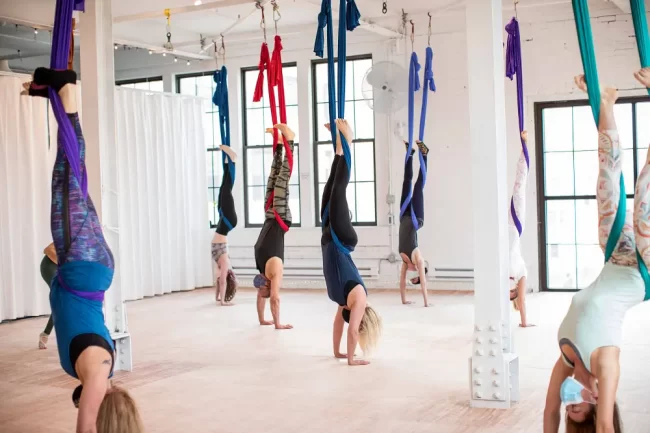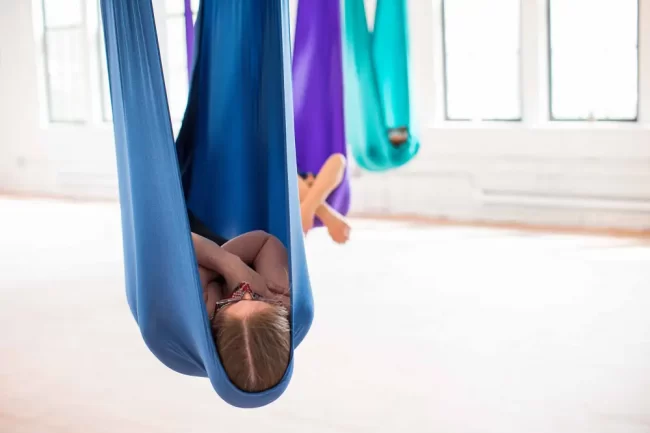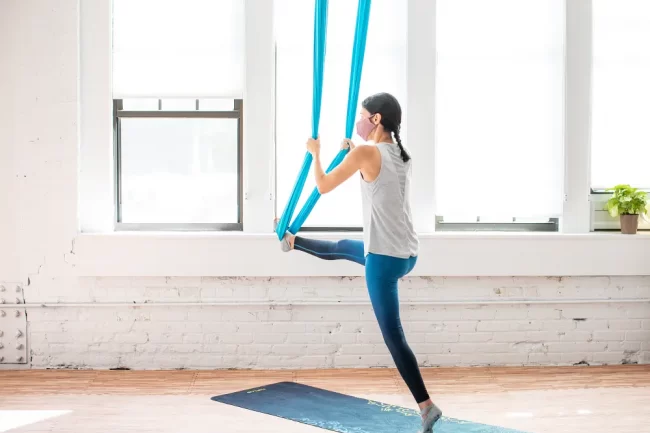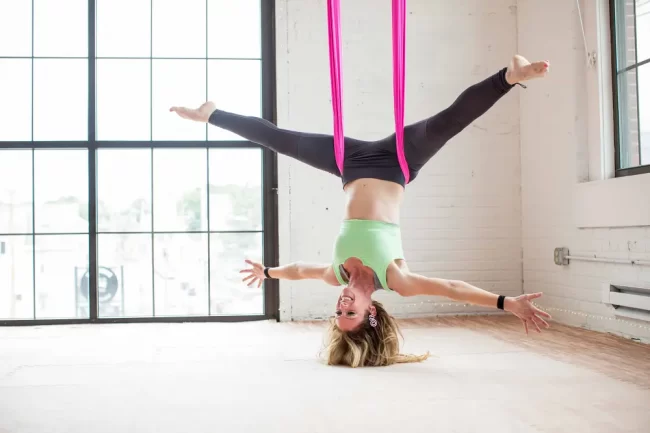What comes to mind when you think of aerial yoga? Do you picture Pink doing the splits suspended from the ceiling? Or maybe you envision the exotic movements of Cirque de Soleil performers—their strong, flexible bodies climbing up and down lengths of fabric. Perhaps you’ve simply dismissed aerial yoga as a fad that bears little resemblance to the ancient yogic tradition you know and love.
As someone who is an avid practitioner and a long-time teacher of both, I want to assure you that aerial yoga and yoga are much more similar than they are different. More importantly, both students and teachers of traditional yoga can easily apply their existing knowledge and skills to aerial yoga.
So, if you’re a yogi who’s been debating attending an aerial yoga class or taking an aerial yoga teacher training, here are a few reasons why you shouldn’t think twice.
Same Practice, More Play
Picture your ideal yoga class—it begins with centering, focuses on breath and sensation, moves through increasingly more challenging poses, explores the mind-body connection, inspires playfulness and joy, and ends with a well-deserved rest.
Now, imagine all this, enhanced by the thrill of mastering a seemingly unattainable pose—like a handstand—in your very first class. THIS is aerial yoga.

Aerial yoga can leave you with a true sense of accomplishment, even empowerment. Could this experience co-exist with an opportunity to down-regulate your nervous system and strengthen your mind-body connection through long, luxurious stretches and a pairing of movement with breath? Absolutely!
Same Foundation, More Balance
While aerial yoga offers students the chance to defy gravity from time to time, it also provides plenty of opportunity for them to ground, rest, and rejuvenate.

Just like traditional yoga, aerial yoga classes can start with a mindful centering, sometimes breath work, and end with savasana inside a silk cocoon—a truly unique experience of feeling grounded, while being suspended. And, throughout an aerial yoga class, the opportunity to both connect to the earth and fly away from it invites a sense of balance between effort and ease.
Same Poses, More Variations
As an E-RYT, the aerial yoga I love to teach is firmly grounded in traditional yoga. Familiar yoga poses, like Downward Dog, Warrior, Half Moon, Chair, Plank, etc. are all standard components of my aerial yoga classes, but they’re augmented by the added support, or challenge, of using the silk as a prop. Students find themselves tuning into their bodies even more, in order to relax deeper into a stretch or maintain their balance.

Aerial yoga also provides an amazing opportunity to enhance your proprioception, or your awareness of where you are in space, by offering poses in every possible orientation. You can do a standing splits with one foot on the ground and your other ankle in the silk; or an inverted splits with one leg wrapped, your body draped over the silk and your hands holding your floating bottom calf; or a reclining splits inside the silk with one leg resting and the opposite ankle floating overhead, propped against the edge of the hammock… I think you get the point.
Same Focus, More Sensation
Yoga instructors use language to help their students move with intention, as they turn their attention inward and focus on the cues their bodies are sending. Aerial yoga instinctively builds this mind-body connection, since it is literally impossible, and even dangerous, to be thinking about anything other than what you are doing with your body in that moment. Often the silk also creates a sense of compression, which promptly draws the attention towards sensation.

Consider a familiar pose, like Warrior 2. In the aerial yoga version, your front leg is suspended, with the silk nestled behind the knee and across the back of the thigh. You are still making more or less the same shape, but you instinctively double your focus, as you face the added mental and physical challenge of distributing your weight evenly between your grounded and aerial legs, while unpacking the additional feedback of your hamstring pressing down, and triceps pressing out, into the fabric. Your mind becomes completely consumed by the depth of awareness and sensation in that moment.
Same Journey, More Excitement
I always find it ironic when students tell me they “hate” yoga, yet they end up an avid aerial yogi. The two practices are just so similar! But, there is an element of excitement and playfulness that is unique to aerial yoga.

The aerial yoga experience is distinct—although it incorporates the poses and qualities of traditional yoga, it also infuses them with novelty and nuance. It allows you to explore, be playful, be daring. It shifts your perspective, literally and figuratively.
Are you ready to think, and teach, outside the box? Take an aerial yoga class or sign up for our upcoming Aerial Yoga Teacher Training.
